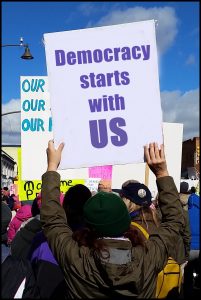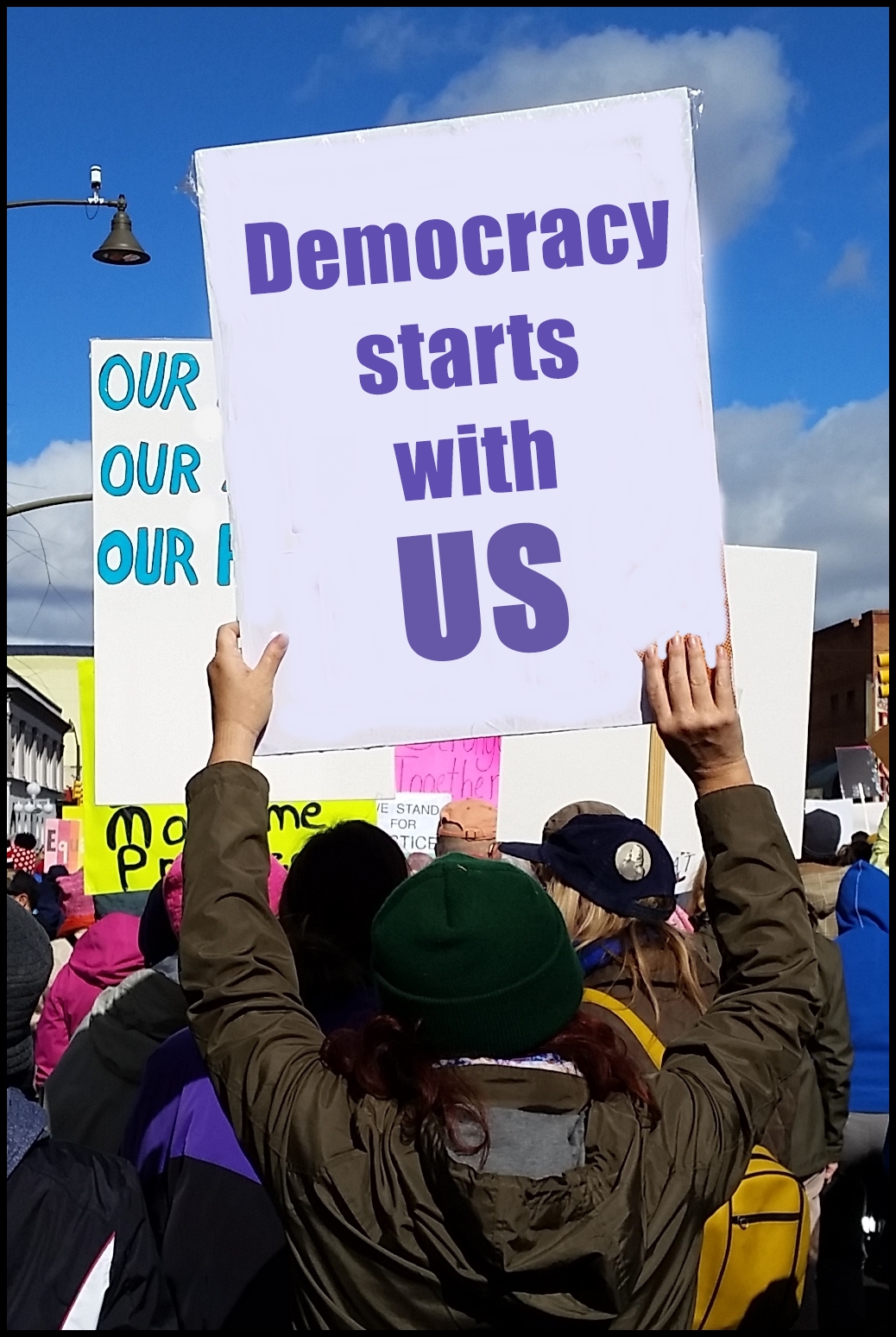In the world of social change, the word “accountability” is bandied about regularly. Unfortunately, beyond the mandate for compliance with legal entities and the regularly-noted-yet-little-understood notion of “accountability to the community we serve,” there is little discussion of what accountability really means.
 Accountable to whom?
Accountable to whom?
For what?
And what does that accountability look like in action?
As part of restructuring Creating the Future to better accomplish our mission, our board has been shifting to a focus on keeping the organization compliant – meeting the expectations of those people and entities who have expectations of us. Because the reality is that those individuals and entities are going to expect those things from us, whether we are mindful of those expectations or not.
During our March meeting, therefore, we used Catalytic Thinking to begin listing all those individuals and entities, noting what expectations they have of us. You can find that list here.
During our April meeting, we then moved to the next set of questions in the Catalytic Thinking framework – the “high potential” question. If we met all the expectations of all those individuals and entities, what would that make possible for accomplishing our mission?
 Before providing the summary of that conversation, we urge you to click through to the meeting itself, either to watch or listen (you can download just the audio), simply because this was one of the most energizing discussions! We hope the summary below entices you to hear the exact words that were spoken, in people’s own voices. To that end, we have noted specific time-stamps in the video, that relate specifically to the content below.
Before providing the summary of that conversation, we urge you to click through to the meeting itself, either to watch or listen (you can download just the audio), simply because this was one of the most energizing discussions! We hope the summary below entices you to hear the exact words that were spoken, in people’s own voices. To that end, we have noted specific time-stamps in the video, that relate specifically to the content below.
Importantly, we hope you will be part of the conversation we will have at our May meeting, to be part of these energizing discussions yourself. If you are a governance or organizational design geek, or you just sense that social change organizations can do much better, we hope you will share your insights during that May meeting.
If we meet the expectations
of all the entities and individuals
who have expectations of us,
what will that make possible –
for those individuals and for accomplishing our mission?
The following is a summary of the discussion that question sparked.
(Spoiler alert: We saved the big one for last!)
Systems for meeting expectations will free us up to work on the mission
As Karl Wilding put it during the meeting, “If the hygiene factors are taken care of, we can focus on what we’re really here for – to change the world.” With systems for things like human resources and internal financial controls in place, we could feel free of the worry that some compliance issue was waiting to bite us.
Meeting those expectations is one precondition for trust, a place where employees and partners and anyone with whom we interact knowing what to expect.
As Justin Pollock noted, “Compliance is the minimum structural element. Our success can be tarnished by failure to comply with not just legal regulations but societal norms and expectations. Therefore one piece of compliance is making sure that pillar is strong. And then recognizing that that’s just a checkmark, the bare minimum.”
 Meeting those Expectations is about Walking our Talk – Our Mission in Action
Meeting those Expectations is about Walking our Talk – Our Mission in Action
Meeting expectations is about people’s values. If we want people to trust us, that will be based not just on the outcomes we accomplish, but how we do the work to accomplish those outcomes.
Meeting those expectations moves our mission beyond a thing we do – it is about BEING the mission, modeling who we are out in the world. Importantly, when we fail to walk our talk – fail to meet the expectations people have of us – we are actually proving that what we espouse doesn’t really work.
The example was cited of the domestic violence organization whose board was so abusive to the staff that the staff unionized to protect themselves from the board. What that tells the community is, in essence, “Yes, we espouse respectful relationships, but in reality, even we can’t figure out how to be respectful to each other…”
 Meeting Expectations Creates Engagement, Creating Shared Power and Individual Efficacy / Agency
Meeting Expectations Creates Engagement, Creating Shared Power and Individual Efficacy / Agency
Engagement is at the heart of accomplishing any social mission, creating ripples of that work out into the world at large. Prior to someone trusting us, they must feel connected to us.
As Justin Pollock noted, this is about fostering true engagement, where people see and feel their actions are effective. “I feel like what I’m doing is actually making a difference.”
This level of engagement allows power to be shared vs. hoarded. Coming back to the issue of accountability, Justin noted, “When we are engaged, the people whose expectations are being met are the ones who will keep us accountable. Because our direct beneficiaries will tell us ‘This is working / this is not.’ Our constituency will hold the space for our accountability.
The more we are meeting those expectations, the more people will want to engage. That turns engagement into deeper engagement. This goes beyond buzz words like collaboration. It is about building relationship into the DNA of everything we do.
The opposite of that is what we so often see – organizations becoming the center of their own universe, meeting the world with an us-and-them approach. If we are truly meeting the expectations of our constituency, we are all one big WE.
 Focusing Our Board on Compliance / Meeting Expectations Democratizes the Board
Focusing Our Board on Compliance / Meeting Expectations Democratizes the Board
The following is a bit more of a transcription than a summary, because every point built upon the prior point, reaching the crescendo of discussing the powerful focus on democratizing boards. We strongly recommend listening to the conversation as it evolved at this point, because sparks were flying and the energy enlivening. Listen from 45:12 to 1:16:40
Justin Pollock noted that a key question is, “Who best knows whether what we do actually works?” A compliance board would be ensuring that somewhere in the organization there is a transparent, functioning system, that points a) to where the expectations are being articulated and b) ensures that the people who are best positioned to evaluate whether those expectations are being met are the ones doing that evaluation. The role of the board is therefore to ask, “Is this expectation being met?”
This moves away from the ridiculous list of what we currently ask of boards. And it is ridiculous because NO entity of 7-12 people has that breadth of competency. So rather than shoving it all into the board, the board is the facilitator of ensuring that capacity is happening.
Karl Wilding took Justin’s observations one step further, noting that the condition Justin described leads us to recruit “a certain type of board member, who is professional, probably educated with a college degree, and probably more likely to be a white man. This sort of approach is potentially stopping us from recruiting people with the lived experience of the mission, who can talk directly about the direction of the organization. That leads to board conversations that are about compliance vs. about the mission, and to people forgetting why they are there. Which leads to absurd situations such as having a mission minute at the start of a meeting. Really? One minute at the beginning to talk about the mission because you’re spending the other 99% of the time talking about compliance issues?” Listen from 49:18 to 50:40
Justin noted that a board that is focused solely on compliance would be making sure the boxes are checked, and ensuring that the questions are being asked and answered by people who DO understand the nuance of whatever the issue is. HR people would be answering questions related to HR. Community people would be the ones telling us whether programs and systems are working – telling us what successful outcomes would look like and whether our approach is helping to achieve those outcomes.
Jane Garthson added to those observations by noting that this would allow people to focus where they are comfortable and confident. If there are accountants on the board who are more comfortable talking about the finances than the mission, they can focus there. By requiring that the board do the work of compliance (vs ensuring that someone who knows the job is doing that work), we are actually discouraging community people from being on boards.
Dimitri built upon Jane’s thoughts, reflecting on the exclusivity of the “board club” and who gets to be in that club. “In that club, lived experience is NOT there. By being a checkbox compliance board, that can be handled by anyone. This opens the potential for anyone to participate, creating diversity not because you targeted X type of person, but because they feel confident and welcome with a trust relationship based on who they are.”
 Justin then noted that this approach democratizes compliance, because now, being on a compliance board doesn’t require professionalism.
Justin then noted that this approach democratizes compliance, because now, being on a compliance board doesn’t require professionalism.
“It requires the ability to inquire in a particular way. And even if English is your second language – you can do that. You can feel comfortable being an agent of compliance. For some that is not sexy. For some it may be access to power and control they’ve never had in their life, to inquire “is this working right?” When you develop the infrastructure of a compliance board, and help people with the kinds of question they need to be asking and the answers they need to be looking for, you open it up to anyone who is able to ask those questions. And we begin to build confidence and competence in that space, which is transferable to other things.
“I was thinking that a compliance board would have to be highly professional. It’s just the opposite. We can structure it in a way that is highly democratic.
Reflections:
At the end of the meeting, our board members brought their personal reflections into the mix, noting what was standing out for them in the conversation. Rather than paraphrase those observations, we urge you to listen for yourself – from 1:18:29 to the end of the meeting at 1:33:55.
As this story continues…
As you read through this summary and/or listen to the actual conversation, are there thoughts that arise for you beyond what we’ve noted here? What stands out to you in the conversation? We look forward to hearing your thoughts in the comments below.
And if you would like to be involved in this work to reshape how organizations are structured to accomplish social missions, let us know. We are eager for more people to join the party!

